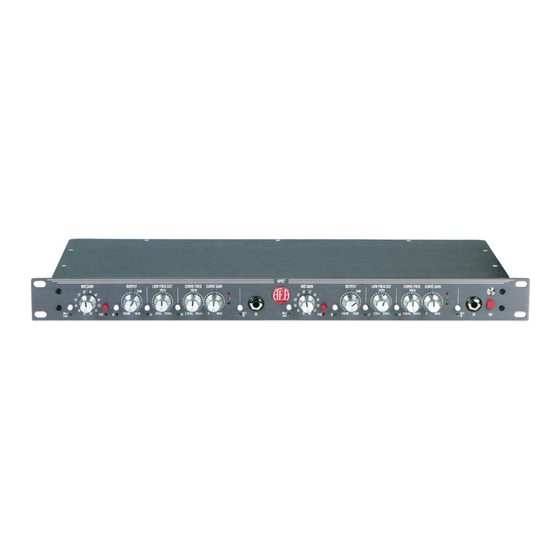
Subscribe to Our Youtube Channel
Summary of Contents for AEA RPQ2
- Page 1 ribbonmics & preamps since 1964 www.ribbonmics.com | tel: +1-626-798-9128 2-CHANNEL, FULL-RACK PREAMP WITH EQ & DI OWNER’S MANUAL Revision 1, September 2016...
-
Page 2: Welcome
WELCOME Congratulations on your purchase of the RPQ2 preamp and welcome to the AEA family. We at AEA take sonic integrity seriously and have created preamps that have been specially designed to meet the particular challenges of ribbon mics and to bring out their full potential. -
Page 3: Table Of Contents
TABLE OF CONTENTS WELCOME INTRODUCTION GENERAL GUIDELINES FRONT PANEL GUIDE REAR PANEL CONNECTIONS INPUT & OUTPUT CONNECTIONS Input Connections Microphone Input Mode Line Input Mode Direct Input Mode Output Connections Input Impedance SETTING THE GAIN Microphone Input Mode Line and Direct Input Mode THE EQ SYSTEM Using the LF Filter Using the HF CurveShaper... -
Page 4: Introduction
With phantom power disengaged, the NoLoad™ input impedance at 63K Ohms means the RPQ2 won’t load down a mic and change its sound. The RPQ2’s CurveShaper™ EQ gives you the tools to control your ribbons right at the start of the signal path. -
Page 5: Front Panel Guide
FRONT PANEL GUIDE 1- Mic/Line switch: OUT is Mic Input mode; IN is Line Input mode which bypasses the mic preamp stage to accomodate line-level signals. The LED below the switch will indicate when the Line Input mode is engaged. 2 - Mic Gain rotary switch: This twelve-position switch selects from +13dB to +62dB of preamplifier gain, as measured between the XLR input and the 1/4”... - Page 6 7 - Low Frequency Filter control: This continuously variable control adjusts the -3dB break-frequency of the filter from 22 Hz to 515 Hz; maximum LF reduction is -20dB. 8 - High Frequency (HF) In switch: OUT is true bypass; IN inserts the CurveShaper™ circuitry. The green LED below switch will indicate when HF boost is engaged.
-
Page 7: Rear Panel Connections
REAR PANEL CONNECTIONS A- Balanced Output - XLR: Female three-pin XLR: pin-1 is ground, pin-2 is high (+), and pin-3 is low (-). B - Balanced 1/4” Line In Input: Line Input mode connector. Bypasses the mic preamp gain stage to accommodate line-level signals. -
Page 8: Input & Output Connections
1) Mic preamp routed into optional EQ. 2) Line level stand-alone EQ. 3) DI routed into optional EQ. Each RPQ2 channel provides an XLR input (Mic Input mode), a 1/4” front panel unbalanced DI, and a back panel Line In 1/4” connector (Line Input mode). -
Page 9: Line Input Mode
Line Input mode allows you to insert compressors or other effects between the preamp and CurveShaper™ EQ section. While the Mic/ Line switch is depressed, the preamp section of the RPQ2 is still active; however, it is independent of the Output Level control and CurveShaper™... -
Page 10: Output Connections
XLR and are not using the direct input, check if the DI switch is engaged. The output of the RPQ2 emulates a transformer-coupled output and can be used as either a balanced or unbalanced signal (depending on how your cable/system is configured). -
Page 11: Setting The Gain
DAW, console, or tape machine. On the RPQ2, if the red LED is illuminated too often or too long, reduce the Mic Gain control one step at a time until it illuminates... -
Page 12: Line And Direct Input Mode
Using the LF Filter The RPQ2 was designed to complement ribbon microphones. AEA Big Ribbon™ mics deliver sub-woofer lows, which the RPQ2 renders faithfully. Such strong low-frequency content can mask high-frequency intelligibility, so the tunable low-frequency (LF) filter was engineered... - Page 13 “P-pops” and breath-noise. However, a fixed-frequency, constant slope low-cut filter cannot handle all situations effectively. The RPQ2 offers a flexible LF filter that can be tailored to satisfy the varying and critical demands of both speech and music.
-
Page 14: Using The Hf Curveshaper™ Eq
Using the HF CurveShaper™ EQ The RPQ2 features a unique CurveShaper™ circuit that enables you to add a little extra “presence” or “air” to compensate for high-frequency losses that are inherent to most ribbon microphones, the result of distant mic placement, or to restore presence in a “dry” acoustical environment. - Page 15 Note: When the Curve Gain is fully counter-clockwise (set in the “0” position), no EQ will be introduced into the signal. It essentially the same as having the HF In Switch (ref #8) disengaged.
-
Page 17: Specifications
+24 dBu to warn of approaching signal overload. 1U, Full-rack measured with knobs and Dimensions: switches: 19” w, 9” d, 1.75” h (48.5 cm x 23 cm x 4.45 cm) 4lb 5oz (~2 kg) Weight: Download the RPQ2 recall sheet online at www.ribbonmics.com/preamps/rpq2... -
Page 20: Warranty
WARRANTY Your RPQ2 comes with a one-year limited warranty on parts and labor, shipping not included. Please see the supplied warranty card for details. Registering your preamp with AEA will extend the warranty to a full three years. Simply fill out the supplied registration form and send it to: Audio Engineering Associates 1029 N.






Need help?
Do you have a question about the RPQ2 and is the answer not in the manual?
Questions and answers